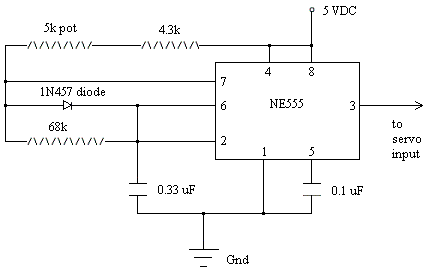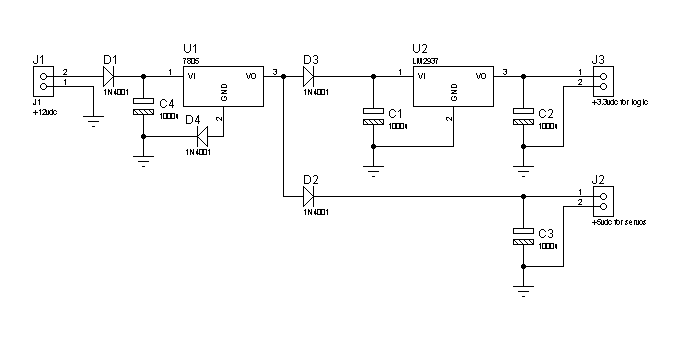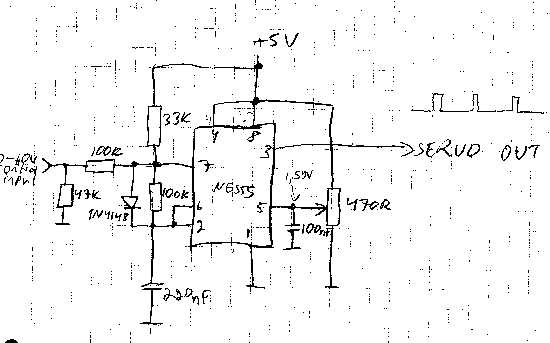
RC Servos

A servo is a general term for an automatic control system, derived from the Latin word "servus," meaning slave. It refers to a mechanism that can be set and forgotten, self-adjusting during operation through feedback. For instance, disk drives utilize a servo system to maintain a constant rotation speed by measuring their current speed and adjusting it as necessary. Feedback can be understood through the analogy of driving a car at a constant speed, where the driver uses the speedometer to gauge their speed and make adjustments accordingly. This process is known as "closed-loop" control. An automobile's cruise control operates similarly, maintaining a set speed by adjusting the throttle as needed.
In the realm of consumer electronics, the most recognizable servos are those found in radio-controlled (RC) devices such as model airplanes and boats. These servos consist of a control mechanism that receives input from the operator, a position-sensing mechanism that determines the current position of the output shaft, and control circuitry that computes the difference between the desired and actual positions. The servo motor then adjusts the position based on this difference, moving rapidly for large discrepancies and more subtly for smaller ones.
RC servos are particularly useful for precision applications, such as animating figures with moving parts. There are various types of servos available, differing in precision, speed, and strength, which is reflected in their pricing. The RC model market is substantial, with numerous manufacturers like Airtronics, Cirrus, FMA Direct, Futaba, Hitec, JR, Ko Propo, Multiplex, and Tower Hobbies producing these devices. Most servos operate on approximately 6V DC and utilize a PWM pulse stream to indicate position. However, different brands have historically used various connector layouts, complicating compatibility. Fortunately, there is a growing industry focused on standardizing these connectors. Care should be taken when using older or used servos, as they may have outdated or modified connectors. Modern servo connectors typically have the positive power connection in the middle, preventing damage from incorrect connections. While most servos are designed for 6 volts, some may require lower or higher voltages, such as micro servos at 4.8 volts or high-powered servos needing more. All RC servos feature three connections: positive power, ground, and signal.
The comprehensive understanding of servos extends to their applications in various fields, including robotics, automation, and model hobbyist activities. In robotics, servos are crucial for creating articulated movements, allowing for the development of robots that can mimic complex motions and tasks. In industrial automation, servos are employed for precise control of machinery and processes, enhancing efficiency and accuracy in manufacturing environments. The versatility of servos is further demonstrated in their use in animatronics, where they enable lifelike movements in characters for entertainment purposes.
Moreover, the integration of servos with microcontrollers and sensors has led to sophisticated control systems that can adapt to real-time inputs, further enhancing their functionality. For instance, servos can be interfaced with feedback sensors to create advanced control loops that automatically adjust positions based on environmental changes or user inputs. This capability is vital in applications such as drone flight control, where maintaining stability and responsiveness is essential.
Overall, the servo mechanism's ability to provide controlled motion through feedback and adjustment makes it an invaluable component in a wide range of electronic applications, from simple hobby projects to complex industrial systems. Understanding the specifications and operational characteristics of different servo types is crucial for selecting the appropriate model for specific applications, ensuring optimal performance and reliability.A "servo" is a generic term used for an automatic control system. It comes from the Latin word "servus" - slave. In practical terms, that means a mechanism that you can set and forget, and which adjusts itself during continued operation through feedback. Disk drives, for example, contain a servo system insuring that they spin at a desired constant speed by measuring their current rotation, and speeding up or slowing down as necessary to keep that speed. What is "feedback" Think about driving a car, and wanting to keep your speed smack on 55 MPH. You are cruising along, and occasionally glance at the speedometer. If your speed is under 55, you press down harder on the gas pedal. If your speed is over 55, you lift your foot. The speedometer gives you feedback - information about how fast you really are going. The brain uses this to decide whether to press down or raise the foot. This is also known as "closed loop" control. An automobile`s "cruise control" is a closed loop system that works similar to the way that you do while driving.
You establish a set point, and if the speed is below that, the cruise control presses down on the gas pedal. The most common consumer-visible servo is that used to operate radio controlled (RC) model planes, boats, and other gadgets.
These are small boxes that contain: The controlling intelligence, in this case the operator of the model, indicates to the servo the position that the output shaft should have. The position-sensing mechanism tells the servo what position the shaft currently has. The control circuitry notes the difference between the desired position and the current position, and uses the motor to "make it so".
If the difference in position is large, the motor moves rapidly to the correct position; if the difference is small, the adjustment is more subtle. As for the operator, all he knows is that he moved a slider half-way up, and the rudder on his model plane moved to the center position, and will stay there until he moves the slider again.
RC servos have a huge amount of haunt potential for precision animation. Just imagine a skull head with eyeballs that can track left to right, following guests as they walk by. There are numerous types of servos. They differ in their precision, speed, and strength - all of which are reflected in price. This is as it should be - you shouldn`t have to pay for a ball-bearing, metal-gear, high-precision servo, when your application can get by with a cheaper kind.
The radio controlled model market is evidently a lucrative one - there are numerous companies making RC servos: Airtronics, Cirrus, FMA Direct, Futaba, Hitec, JR, Ko Propo, Multiplex, Tower Hobbies. The good news is that all of these servos feed off of the same electrical connections: roughly 6VDC to power the thing, and a PWM pulse stream to indicate position.
The bad news is that just about everybody formerly used a different connector layout for these same signals. If you are using an Airtronics, you can`t just plug a Futaba in its place. Luckily, this silliness has been noticed - there is an entire industry that revolves around replacing the various connectors with a plug-compatible arrangement.
And, as time marches on, the various brands slowly converge on a standard. If you buy a used servo, or remove a servo from old equipment it may have a strange old connector. The connector may even have been replaced or modified in the past. Use caution! Just about all modern servo connectors put the positive power in the middle. With this arrangement, plugging in a servo backwards won`t hurt anything - it simply won`t work. Most servos are designed to work on 6 volts. Some special servos may require a lower voltage (e. g. a micro servo may be limited to 4. 8 volts) and others may require higher voltage (e. g. high powered servos). As has already been mentioned, all RC servos have three connections: power (positive), power (ground or ne 🔗 External reference
In the realm of consumer electronics, the most recognizable servos are those found in radio-controlled (RC) devices such as model airplanes and boats. These servos consist of a control mechanism that receives input from the operator, a position-sensing mechanism that determines the current position of the output shaft, and control circuitry that computes the difference between the desired and actual positions. The servo motor then adjusts the position based on this difference, moving rapidly for large discrepancies and more subtly for smaller ones.
RC servos are particularly useful for precision applications, such as animating figures with moving parts. There are various types of servos available, differing in precision, speed, and strength, which is reflected in their pricing. The RC model market is substantial, with numerous manufacturers like Airtronics, Cirrus, FMA Direct, Futaba, Hitec, JR, Ko Propo, Multiplex, and Tower Hobbies producing these devices. Most servos operate on approximately 6V DC and utilize a PWM pulse stream to indicate position. However, different brands have historically used various connector layouts, complicating compatibility. Fortunately, there is a growing industry focused on standardizing these connectors. Care should be taken when using older or used servos, as they may have outdated or modified connectors. Modern servo connectors typically have the positive power connection in the middle, preventing damage from incorrect connections. While most servos are designed for 6 volts, some may require lower or higher voltages, such as micro servos at 4.8 volts or high-powered servos needing more. All RC servos feature three connections: positive power, ground, and signal.
The comprehensive understanding of servos extends to their applications in various fields, including robotics, automation, and model hobbyist activities. In robotics, servos are crucial for creating articulated movements, allowing for the development of robots that can mimic complex motions and tasks. In industrial automation, servos are employed for precise control of machinery and processes, enhancing efficiency and accuracy in manufacturing environments. The versatility of servos is further demonstrated in their use in animatronics, where they enable lifelike movements in characters for entertainment purposes.
Moreover, the integration of servos with microcontrollers and sensors has led to sophisticated control systems that can adapt to real-time inputs, further enhancing their functionality. For instance, servos can be interfaced with feedback sensors to create advanced control loops that automatically adjust positions based on environmental changes or user inputs. This capability is vital in applications such as drone flight control, where maintaining stability and responsiveness is essential.
Overall, the servo mechanism's ability to provide controlled motion through feedback and adjustment makes it an invaluable component in a wide range of electronic applications, from simple hobby projects to complex industrial systems. Understanding the specifications and operational characteristics of different servo types is crucial for selecting the appropriate model for specific applications, ensuring optimal performance and reliability.A "servo" is a generic term used for an automatic control system. It comes from the Latin word "servus" - slave. In practical terms, that means a mechanism that you can set and forget, and which adjusts itself during continued operation through feedback. Disk drives, for example, contain a servo system insuring that they spin at a desired constant speed by measuring their current rotation, and speeding up or slowing down as necessary to keep that speed. What is "feedback" Think about driving a car, and wanting to keep your speed smack on 55 MPH. You are cruising along, and occasionally glance at the speedometer. If your speed is under 55, you press down harder on the gas pedal. If your speed is over 55, you lift your foot. The speedometer gives you feedback - information about how fast you really are going. The brain uses this to decide whether to press down or raise the foot. This is also known as "closed loop" control. An automobile`s "cruise control" is a closed loop system that works similar to the way that you do while driving.
You establish a set point, and if the speed is below that, the cruise control presses down on the gas pedal. The most common consumer-visible servo is that used to operate radio controlled (RC) model planes, boats, and other gadgets.
These are small boxes that contain: The controlling intelligence, in this case the operator of the model, indicates to the servo the position that the output shaft should have. The position-sensing mechanism tells the servo what position the shaft currently has. The control circuitry notes the difference between the desired position and the current position, and uses the motor to "make it so".
If the difference in position is large, the motor moves rapidly to the correct position; if the difference is small, the adjustment is more subtle. As for the operator, all he knows is that he moved a slider half-way up, and the rudder on his model plane moved to the center position, and will stay there until he moves the slider again.
RC servos have a huge amount of haunt potential for precision animation. Just imagine a skull head with eyeballs that can track left to right, following guests as they walk by. There are numerous types of servos. They differ in their precision, speed, and strength - all of which are reflected in price. This is as it should be - you shouldn`t have to pay for a ball-bearing, metal-gear, high-precision servo, when your application can get by with a cheaper kind.
The radio controlled model market is evidently a lucrative one - there are numerous companies making RC servos: Airtronics, Cirrus, FMA Direct, Futaba, Hitec, JR, Ko Propo, Multiplex, Tower Hobbies. The good news is that all of these servos feed off of the same electrical connections: roughly 6VDC to power the thing, and a PWM pulse stream to indicate position.
The bad news is that just about everybody formerly used a different connector layout for these same signals. If you are using an Airtronics, you can`t just plug a Futaba in its place. Luckily, this silliness has been noticed - there is an entire industry that revolves around replacing the various connectors with a plug-compatible arrangement.
And, as time marches on, the various brands slowly converge on a standard. If you buy a used servo, or remove a servo from old equipment it may have a strange old connector. The connector may even have been replaced or modified in the past. Use caution! Just about all modern servo connectors put the positive power in the middle. With this arrangement, plugging in a servo backwards won`t hurt anything - it simply won`t work. Most servos are designed to work on 6 volts. Some special servos may require a lower voltage (e. g. a micro servo may be limited to 4. 8 volts) and others may require higher voltage (e. g. high powered servos). As has already been mentioned, all RC servos have three connections: power (positive), power (ground or ne 🔗 External reference



